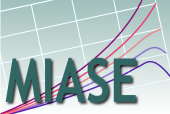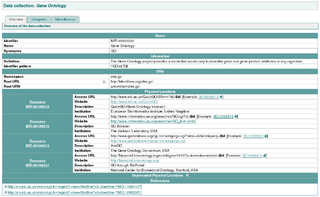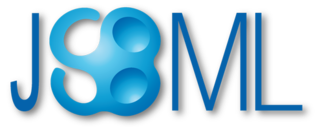
CellML is an XML based markup language for describing mathematical models. Although it could theoretically describe any mathematical model, it was originally created with the Physiome Project in mind, and hence used primarily to describe models relevant to the field of biology. This is reflected in its name CellML, although this is simply a name, not an abbreviation. CellML is growing in popularity as a portable description format for computational models, and groups throughout the world are using CellML for modelling or developing software tools based on CellML. CellML is similar to Systems Biology Markup Language SBML but provides greater scope for model modularity and reuse, and is not specific to descriptions of biochemistry.
Modelling biological systems is a significant task of systems biology and mathematical biology. Computational systems biology aims to develop and use efficient algorithms, data structures, visualization and communication tools with the goal of computer modelling of biological systems. It involves the use of computer simulations of biological systems, including cellular subsystems, to both analyze and visualize the complex connections of these cellular processes.
The Systems Biology Markup Language (SBML) is a representation format, based on XML, for communicating and storing computational models of biological processes. It is a free and open standard with widespread software support and a community of users and developers. SBML can represent many different classes of biological phenomena, including metabolic networks, cell signaling pathways, regulatory networks, infectious diseases, and many others. It has been proposed as a standard for representing computational models in systems biology today.

BioModels is a free and open-source repository for storing, exchanging and retrieving quantitative models of biological interest created in 2006. All the models in the curated section of BioModels Database have been described in peer-reviewed scientific literature.

The Systems Biology Ontology (SBO) is a set of controlled, relational vocabularies of terms commonly used in systems biology, and in particular in computational modeling.

MIRIAM is a community-level effort to standardize the annotation and curation processes of quantitative models of biological systems. It consists of a set of guidelines suitable for use with any structured format, allowing different groups to collaborate and share resulting models. Adherence to these guidelines also facilitates the sharing of software and service infrastructures built upon modeling activities.
Igor I. Goryanin is a systems biologist, who holds a Henrik Kacser Chair in Computational Systems Biology at the University of Edinburgh. He also heads the Biological Systems Unit at the Okinawa Institute of Science and Technology, Japan.

The minimum information about a simulation experiment (MIASE) is a list of the common set of information a modeller needs to enable the execution and reproduction of a numerical simulation experiment, derived from a given set of quantitative models.
NeuroML is an XML based model description language that aims to provide a common data format for defining and exchanging models in computational neuroscience. The focus of NeuroML is on models which are based on the biophysical and anatomical properties of real neurons.
Virtual Cell (VCell) is an open-source software platform for modeling and simulation of living organisms, primarily cells. It has been designed to be a tool for a wide range of scientists, from experimental cell biologists to theoretical biophysicists.
LibSBML is an open-source software library that provides an application programming interface (API) for the SBML format. The libSBML library can be embedded in a software application or used in a web servlet as part of the application or servlet's implementation of support for reading, writing, and manipulating SBML documents and data streams. The core of libSBML is written in ISO standard C++; the library provides API for many programming languages via interfaces generated with the help of SWIG.

The MIRIAM Registry, a by-product of the MIRIAM Guidelines, is a database of namespaces and associated information that is used in the creation of uniform resource identifiers. It contains the set of community-approved namespaces for databases and resources serving, primarily, the biological sciences domain. These shared namespaces, when combined with 'data collection' identifiers, can be used to create globally unique identifiers for knowledge held in data repositories. For more information on the use of URIs to annotate models, see the specification of SBML Level 2 Version 2.

JSBML is an open-source Java (API) for the SBML format. Its API strives to attain a strong similarity to the Java binding of the corresponding library libSBML, but is entirely implemented in Java and therefore platform independent. JSBML provides an elaborated abstract type hierarchy, whose data types implement or extend many interfaces and abstract classes from the standard Java library. In this way, JSBML integrates smoothly into existing Java projects, and provides methods to read, write, evaluate, and manipulate the content of SBML documents.
Identifiers.org is a project providing stable and perennial identifiers for data records used in the Life Sciences. The identifiers are provided in the form of Uniform Resource Identifiers (URIs). Identifiers.org is also a resolving system, that relies on collections listed in the MIRIAM Registry to provide direct access to different instances of the identified records.

The Kinetic Simulation Algorithm Ontology (KiSAO) supplies information about existing algorithms available for the simulation of systems biology models, their characterization and interrelationships. KiSAO is part of the BioModels.net project and of the COMBINE initiative.

COMBINE, the COmputational Modeling in BIology NEtwork, is an initiative to coordinate the development of the various community standards and formats for computational models, initially in systems biology and related fields.
Multi-state modeling of biomolecules refers to a series of techniques used to represent and compute the behaviour of biological molecules or complexes that can adopt a large number of possible functional states.
Nicolas Le Novère is a British and French biologist. His research focuses on modeling signaling pathways and developing tools to share mathematical models.









